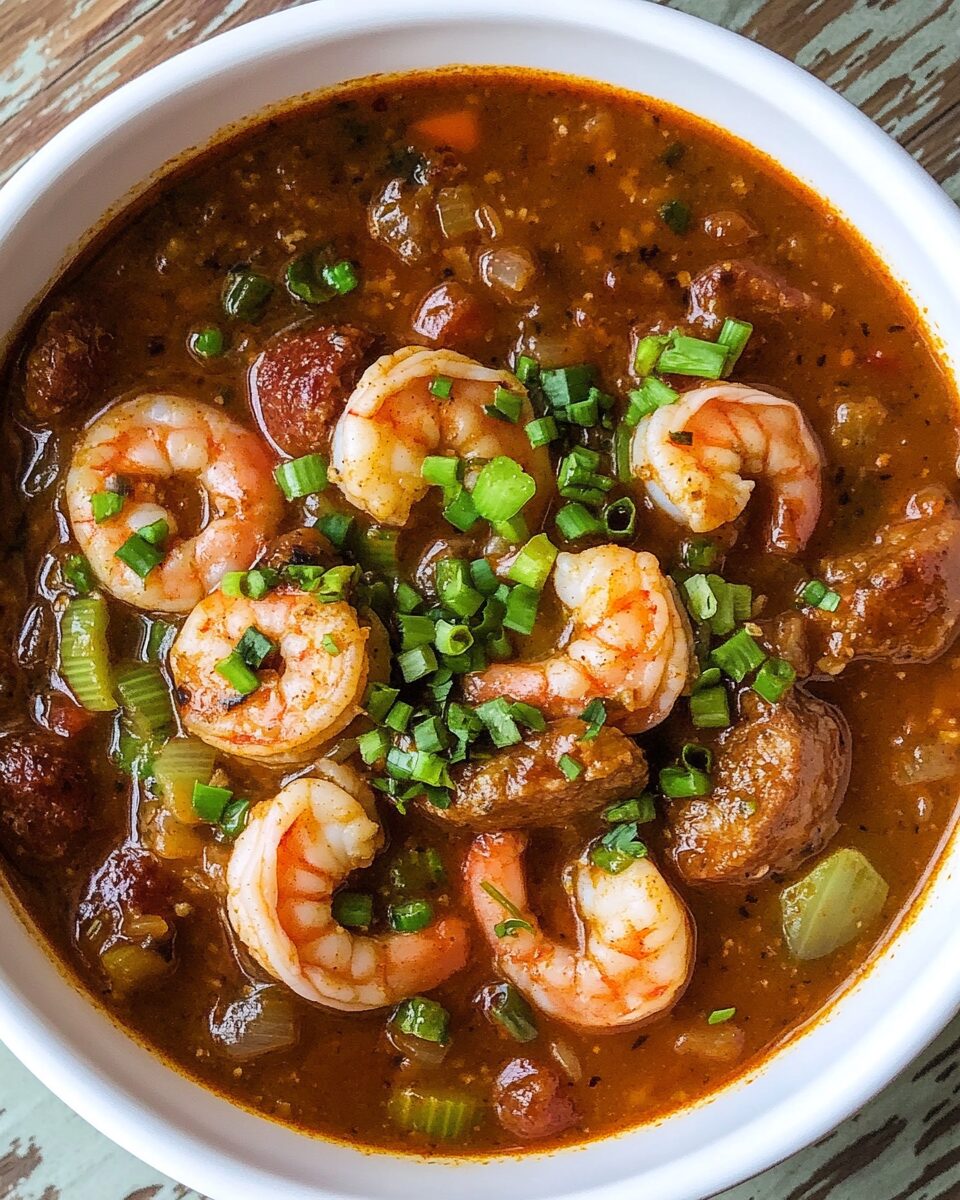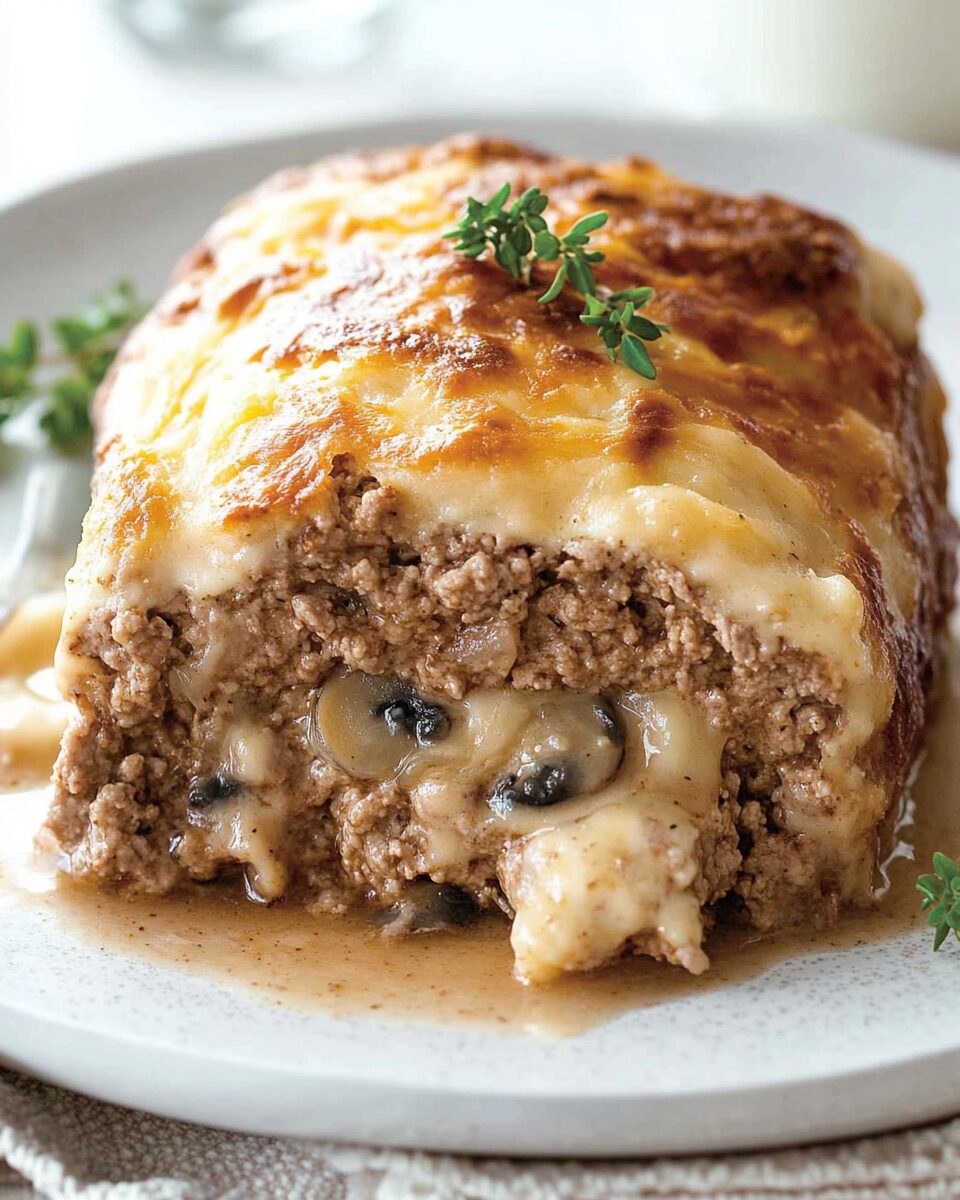This hearty seafood gumbo combines the deep, nutty flavors of a perfectly browned roux with the freshness of shrimp, crab, and andouille sausage. The addition of okra not only thickens the stew but also adds authentic Southern texture and flavor, creating a dish that is both comforting and exciting.
Whether served over a bed of steaming white rice or enjoyed on its own, this gumbo embodies the spirit of Louisiana’s vibrant culinary culture. Its balance of spices and fresh seafood makes it a perfect meal for family dinners, celebrations, or any time you crave a taste of the bayou at home.
Full Recipe:
-
1/2 cup vegetable oil
-
1/2 cup all-purpose flour
-
1 large onion, chopped
-
1 green bell pepper, chopped
-
2 celery stalks, chopped
-
4 cloves garlic, minced
-
1 (14 oz) can diced tomatoes
-
1 quart seafood stock or chicken stock
-
2 bay leaves
-
1 teaspoon dried thyme
-
1/2 teaspoon cayenne pepper (adjust to taste)
-
1 teaspoon smoked paprika
-
Salt and black pepper to taste
-
1 pound shrimp, peeled and deveined
-
1 pound crab meat (lump or claw)
-
1/2 pound andouille sausage, sliced
-
2 cups okra, sliced (fresh or frozen)
-
2 tablespoons Worcestershire sauce
-
3 green onions, chopped
-
1/4 cup fresh parsley, chopped
-
Cooked white rice, for serving
Directions:
-
In a large heavy pot or Dutch oven, heat the vegetable oil over medium heat. Gradually whisk in the flour to make a roux. Cook, whisking constantly, until the roux turns a deep brown color, about 15-20 minutes. Be careful not to burn it.
-
Add the onion, bell pepper, celery, and garlic to the roux and cook until vegetables soften, about 5 minutes.
-
Stir in the diced tomatoes, seafood stock, bay leaves, thyme, cayenne pepper, smoked paprika, Worcestershire sauce, salt, and pepper. Bring to a simmer and let cook uncovered for 30 minutes, stirring occasionally.
-
Add the andouille sausage, okra, shrimp, and crab meat. Simmer until the seafood is cooked through, about 10 minutes.
-
Remove bay leaves, then stir in green onions and parsley. Adjust seasoning if needed.
-
Serve hot over cooked white rice.
Prep Time: 20 minutes | Cooking Time: 1 hour | Total Time: 1 hour 20 minutes
Kcal: Approximately 400 kcal per serving | Servings: 6 servings
The History and Origins of Seafood Gumbo
Seafood gumbo is a quintessential dish that embodies the rich cultural heritage of Louisiana, particularly the vibrant city of New Orleans. Its origins can be traced back to a fusion of culinary traditions brought by various cultures that settled in the region, including French, Spanish, African, and Native American influences. The word “gumbo” itself is derived from a West African term for okra, one of the key thickening ingredients traditionally used in the stew. This dish evolved as a practical, communal meal, where local seafood and available vegetables were simmered together with spices to create a deeply flavorful and nourishing dish.
Over time, gumbo became a symbol of Louisiana’s melting pot culture and its love for bold, layered flavors. It is often considered the unofficial state dish and is celebrated for its versatility — it can include a variety of proteins, from chicken and sausage to different types of seafood, including shrimp, crab, and oysters.
The Essence of a Perfect Roux
One of the defining features of this seafood gumbo is the roux — a rich mixture of flour and fat cooked until it reaches a deep brown color. The roux is the backbone of the dish, providing both flavor and thickness. Achieving the perfect roux takes patience and attention, as it requires constant stirring and careful temperature control to avoid burning.
The darker the roux, the deeper and more complex the flavor profile becomes. This process imparts a slightly nutty, caramelized taste that enhances the overall gumbo experience. Many home cooks and chefs alike consider the roux the true test of their gumbo-making skills.
The Role of Okra and Other Thickeners
Okra is a traditional ingredient in seafood gumbo and plays an essential role in thickening the broth while adding a subtle vegetal flavor. When cooked, okra releases a natural mucilage that helps to create the characteristic silky texture of gumbo. Though fresh okra is preferred for its flavor and texture, frozen okra can be a convenient alternative without compromising much on quality.
Aside from okra, some recipes incorporate filé powder, made from ground sassafras leaves, as an additional thickening agent. Filé powder is typically added at the end of cooking or sprinkled on top when serving. It also lends a unique, slightly earthy flavor that complements the other seasonings and seafood.
The Importance of Fresh Seafood and Andouille Sausage
The soul of seafood gumbo lies in its fresh, high-quality seafood. Shrimp and crab are staples in most versions, prized for their sweetness and delicate texture that contrasts beautifully with the spicy, robust broth. Andouille sausage, a smoked pork sausage seasoned with garlic and other spices, brings a smoky, savory depth that balances the seafood perfectly.
Using fresh, sustainably sourced seafood makes a significant difference in the final taste. The shrimp should be peeled and deveined, while the crab meat should be picked carefully to avoid shell fragments. Andouille sausage adds not only flavor but also a satisfying chewiness that rounds out the dish’s texture.
Layers of Spices and Aromatics
Cajun and Creole cuisines are famous for their vibrant use of spices and aromatics, and this gumbo is no exception. The flavor profile is built on a foundation of the “holy trinity” of vegetables—onion, bell pepper, and celery—sautéed until tender to create a fragrant base. Garlic enhances this base with pungent warmth.
Cayenne pepper, smoked paprika, thyme, bay leaves, and Worcestershire sauce combine to create a complex spice blend that delivers both heat and smokiness without overpowering the seafood. The balance of spices is crucial; the gumbo should be spicy and lively, yet harmonious, allowing the natural flavors of the seafood and vegetables to shine through.
Serving and Pairing Suggestions
Traditionally, gumbo is served over steamed white rice, which helps to soak up the flavorful broth and provides a neutral base that balances the richness of the dish. Some variations may include crusty French bread on the side to mop up every last bit.
To complement the bold flavors, light and crisp side dishes or salads with citrus vinaigrettes work well, cutting through the spice and richness with a refreshing contrast. For beverages, a cold lager, a light white wine like Sauvignon Blanc, or even a classic Southern sweet tea can be perfect accompaniments.
Cultural Significance and Occasions
Seafood gumbo is more than just a meal — it’s a cultural event. In Louisiana, gumbo is often made for large family gatherings, Mardi Gras celebrations, and community events. It’s a dish that brings people together, reflecting a spirit of sharing and hospitality. Cooking gumbo can be a social experience, where family and friends gather to chop vegetables, stir the roux, and enjoy the anticipation of the final product.
The dish’s significance also lies in its ability to adapt to seasons and available ingredients. In coastal areas, fresh seafood is abundant, while inland versions may lean more heavily on sausage or chicken. This adaptability keeps gumbo relevant and loved by many generations.
Tips for Making Seafood Gumbo at Home
Making gumbo at home can seem intimidating due to the many steps and ingredients involved, but with a few tips, it becomes much more approachable. First, take your time with the roux—it’s worth the patience. Use a heavy-bottomed pot to ensure even heat distribution.
Don’t rush the simmering process, as this allows flavors to meld and develop fully. Taste frequently and adjust seasoning as you go. Fresh herbs like parsley and green onions added at the end brighten the dish and add freshness.
Lastly, remember gumbo often tastes even better the next day, as the flavors continue to deepen overnight. Leftovers can be refrigerated or frozen for easy meals later.
Conclusion
Seafood gumbo is a dish that perfectly captures the heart and soul of Louisiana’s rich culinary heritage. With its deep, smoky roux, tender seafood, bold spices, and comforting textures, it offers a complex yet approachable meal that warms the body and soul. Whether enjoyed as a casual family dinner or a celebratory feast, gumbo remains a timeless classic that celebrates community, tradition, and the joy of cooking.
This recipe, with its authentic flavors and satisfying ingredients, is a wonderful introduction to the world of Cajun and Creole cooking. Its ability to bring together diverse ingredients into a harmonious, flavorful stew is a testament to the power of good food to connect people and cultures across generations. Making gumbo at home allows you to savor a true taste of the bayou, right from your own kitchen. 09478041597








